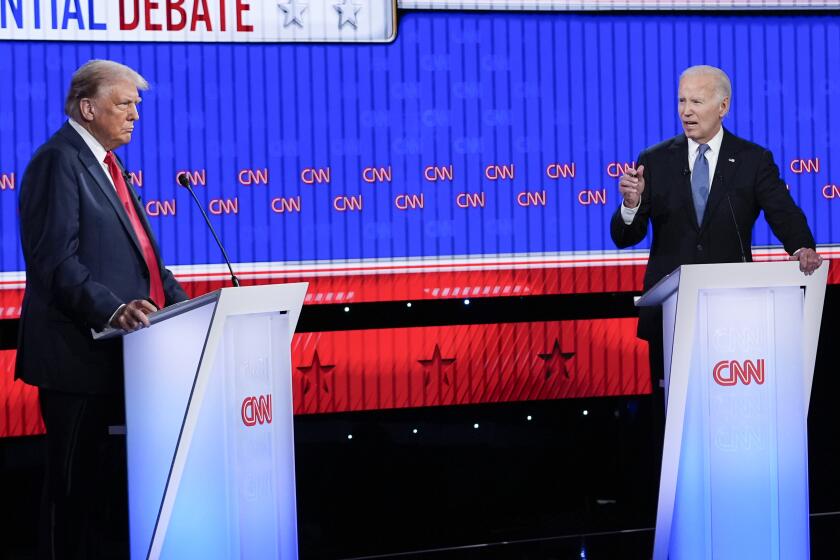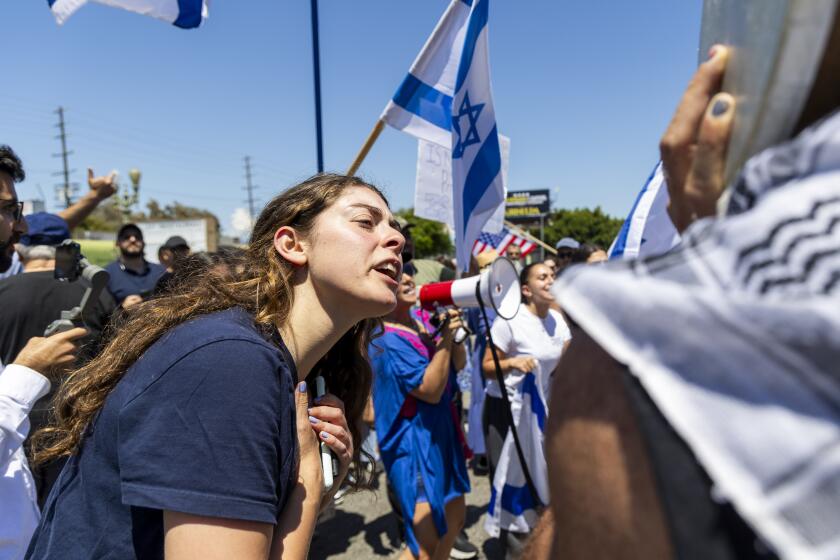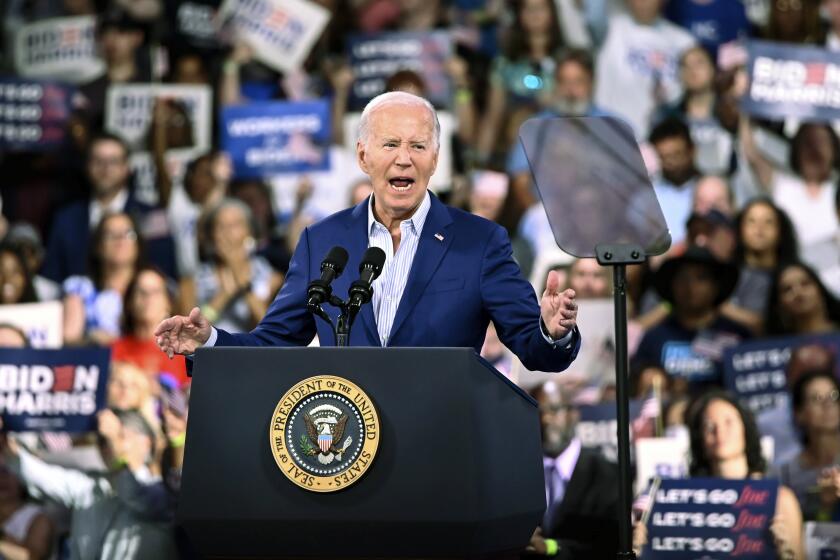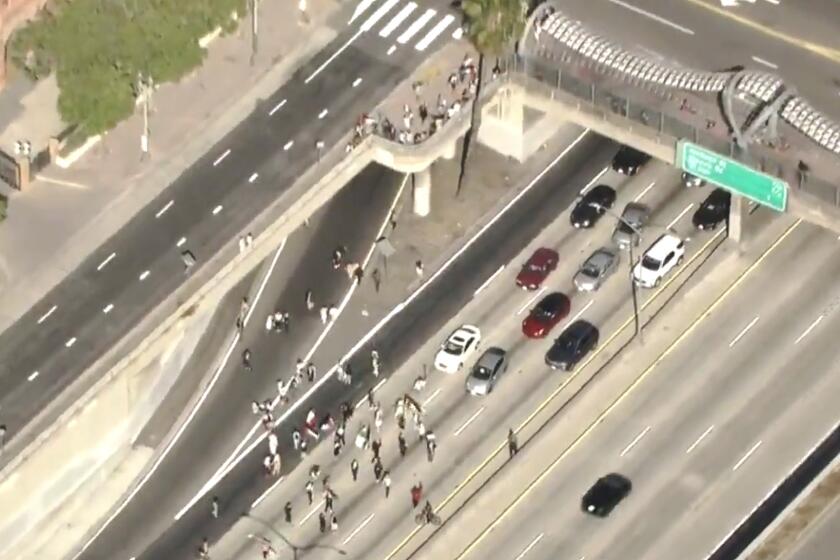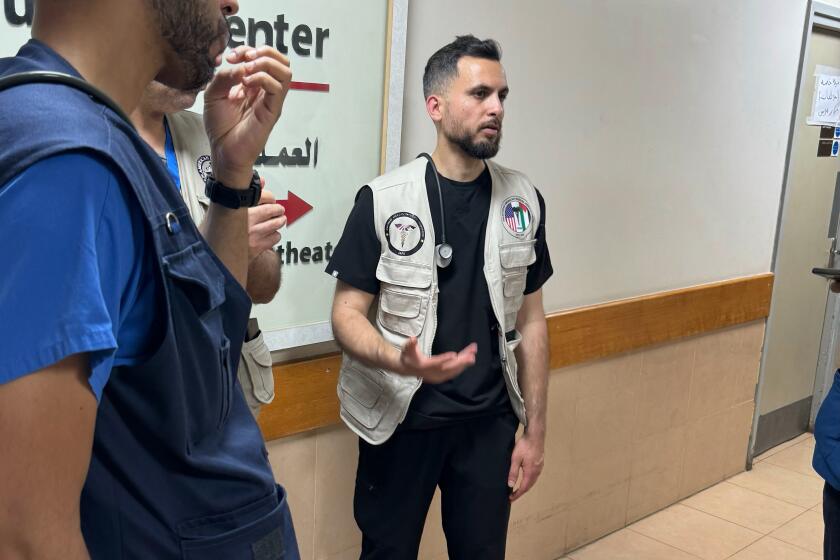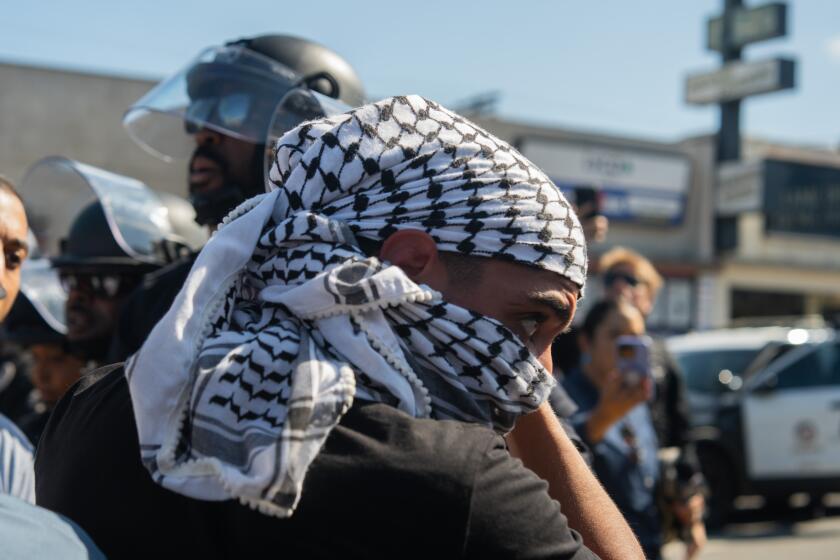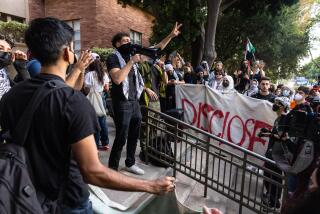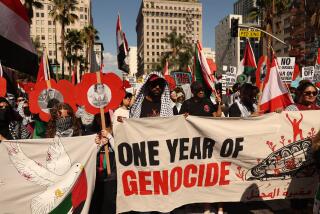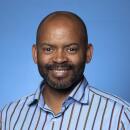What really happened when protesters, counterprotesters and police converged at an L.A. synagogue
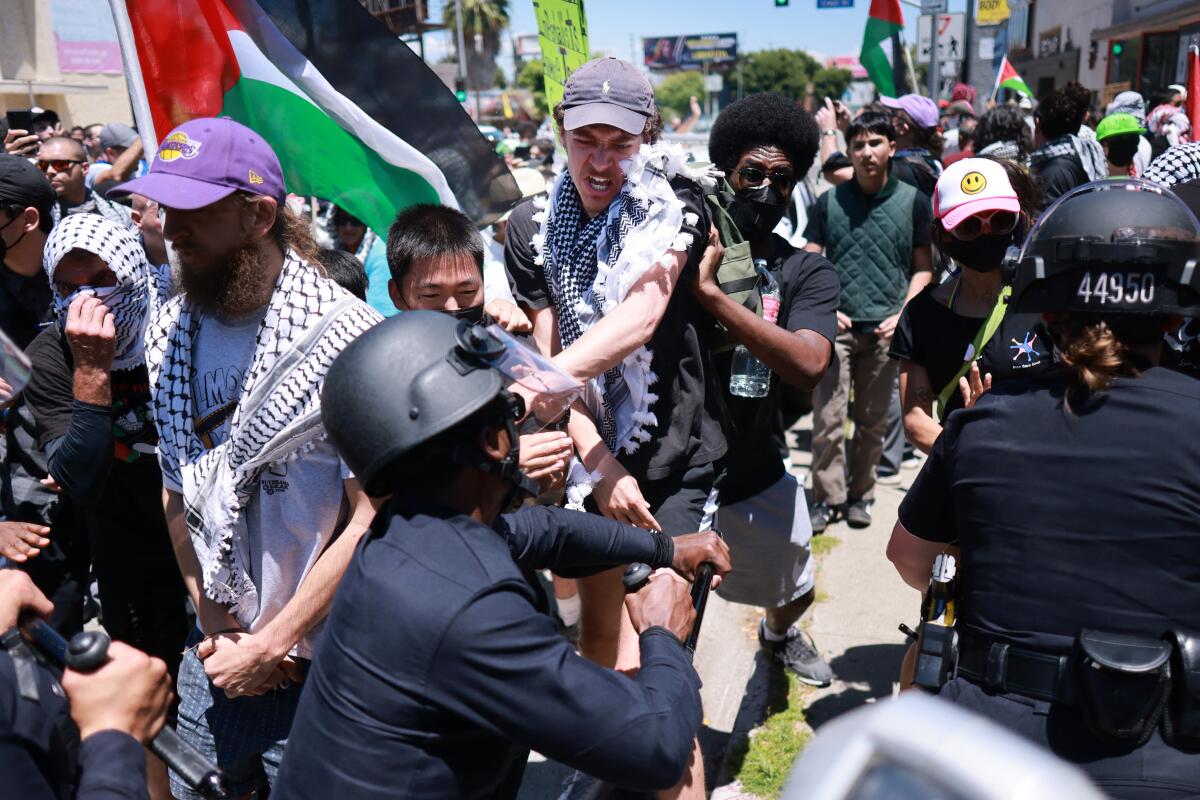
- Share via
Four days after a violent protest outside a Los Angeles synagogue sparked national condemnation, more perspectives have emerged about the events that unfolded, including criticism from both pro-Palestinian and pro-Israel supporters about police tactics used during the demonstration.
A physician based in L.A., who requested anonymity because he fears reprisals, worked as a medic during Sunday’s protest outside the Adas Torah synagogue in the predominantly Jewish Pico-Robertson neighborhood. During the hours-long melee, in which violent clashes broke out between pro-Palestinian supporters and pro-Israel counterprotesters, he said he treated at least 11 people, whose injuries ranged from chest pain and shortness of breath from inhaling pepper spray to a fractured arm.
“This was probably the scariest protest I’ve been to,” he said. “It was very apparent that our police weren’t there to protect us and that any acts of violence that occurred in front of them wouldn’t be met with consequences.”
In the debate against Trump, Biden did little to quiet the concerns that millions of voters have had about the 81-year-old’s mental acuity.
Interim LAPD Chief Dominic Choi previously confirmed that a “mobile field force” tried to disperse the crowd after protesters “attempted to block the entrance of the synagogue.” On Thursday, the LAPD said a synopsis provided to the department at the conclusion of major incidents did not include any references to use of force, and officials referred questions regarding allegations that officers didn’t intervene in the violence to a department news release about the protest, which didn’t address those topics.
A pro-Israel counterprotester who was carrying a spiked pole was arrested, cited and released, and there were two other reports of battery, according to the LAPD. Authorities said a pro-Palestinian protester also used a chemical irritant against at least two officers, which Choi said the department is investigating.
At a public security briefing Wednesday, L.A. Mayor Karen Bass and LAPD Cmdr. Steve Lurie denied that police were told to do nothing. Lurie said no officials gave an order to “stand down and slow or stop any action” during Sunday’s protest.
Law enforcement sources said more than 150 people converged on the temple, and it took time for the Los Angeles Police Department to get enough personnel to the scene.
Sunday’s violence prompted politicians and Jewish community groups to condemn the protest as an act of antisemitism. The demonstration was denounced by national and state elected officials, including President Biden, Vice President Harris and Gov. Gavin Newsom.
“Intimidating Jewish congregants is dangerous, unconscionable, antisemitic and un-American,” Biden said in a statement. “Americans have a right to peaceful protest. But blocking access to a house of worship — and engaging in violence — is never acceptable.”
U.S. Atty. Gen. Merrick Garland announced Thursday that federal investigators would look into Sunday’s protest.
“The U.S. Attorney’s Office for the Central District of California, which is in Los Angeles, the Justice Department’s Civil Rights Division, main Justice and the FBI have been — and, as we speak, are — collecting evidence on that matter,” Garland said during a news conference on healthcare in Washington.
After his weak debate performance, Biden responds to suggestions that he bow out of the presidential race with a firmly voiced promise to beat Trump.
Garland vowed to crack down on antisemitism, his voice trembling as he recalled “having relatives who escaped the Holocaust and some who did not.”
Pro-Palestinian supporters, however, said the protest was not spurred by antisemitism but by a real estate event at the synagogue advertised as providing information on “housing projects in all the best Anglo neighborhoods in Israel.”
The ad that ran in Friday’s Jewish Journal did not specify the location of the real estate.
According to an archive of the website for My Home in Israel, one of the companies listed on the advertisement, homes were listed for $435,000 to $4.1 million in Jerusalem, Tel Aviv and the West Bank territories of Efrat and Ariel. Much of the international community — including the U.S. and the U.N. — says settlements in the West Bank are illegal under international law, which Israel disputes.
The physician, a Los Angeles native, said he volunteered to work as a medic after seeing the protest flier on the Instagram account of the Southern California chapter of the Palestinian Youth Movement.
He said he arrived at the synagogue to find protesters gathered near the entrance. Within 20 minutes, he said, LAPD officers had formed two lines — one on the east side of the block and another on the west, cutting off access to where protesters had parked their cars, effectively “sandwiching” the pro-Palestinian supporters between counterprotesters and police.
“That’s when I began to realize how dangerous the situation was,” he said.
The officers started pushing and using batons to try to get the crowd to disperse, he said. People on both sides of the demonstration were using pepper spray, he noted.
Some tried to hold the line against police, but the medic said he stayed away from the front. Still, he said, an officer lunged and hit him with a baton in his left rib.
“I yelled that I was a medic, but I got a blank face in response,” he said. “There was no regret, no apology, no advice or any guidelines.” The medic said he was not wearing clothing that indicated he was a doctor, but he was carrying a bag with first-aid supplies.
He said he treated at least 11 protesters during the violence that ensued, including seven who had been pepper-sprayed. One woman was sprayed three times in the face as she chanted through a megaphone, he said. He said he treated another person who complained of chest pain and shortness of breath after inhaling pepper spray. Another person’s right arm was fractured after being struck by a police baton, he said.
Three people came to him with bruising, he said: One was hit on the cheekbone by a counterprotester, another was punched in the chin and the third was struck in the right forearm. One protester was pushed to the ground and beaten on his back with wooden sticks, he said.
“There were a lot of people struggling to stay safe,” the medic said. “I was not only treating acute injuries but talking to the organizers and reminding them that it was no longer a productive and safe action and an escape plan needed to be initiated.”
Dozens of pro-Palestinian protesters shutdown the 101 Freeway in downtown Los Angeles on Monday afternoon.
The medic said he and 80 to 100 protesters tried to leave around 1:30 or 2 p.m., but because they were blocked by the police line, they had to use side streets through the neighborhood.
As they tried to make their exit, the medic said, a group of Israel supporters confronted them, sometimes getting into violent skirmishes. He recalled one person from the pro-Israel side shouting, “We have the bullets, you have the blood.”
He said the altercations continued for more than an hour, and he was finally able to get back to his car, parked about a block from the synagogue.
Another pro-Palestinian supporter, who also requested anonymity because of fear of reprisals, told The Times that his group was trying to leave the protest and was chased by pro-Israel supporters. He said the counterprotesters pushed, slapped and punched them and yelled at them to move faster.
Mohamad Abdelfattah, a critical-care doctor, was in the southern city of Rafah with no way of leaving. He was volunteering in one of the few hospitals that has remained open in the besieged city.
Pro-Israel supporters also criticized police for not intervening.
Talia Regev, 43, who said she came to the protest “to make sure things wouldn’t get out of hand,” was speaking to police when she watched her friend Naftoli Sherman fall to the ground, she said.
Sherman, 25, told a Times reporter that he was punched in the left eye by a pro-Palestinian demonstrator. As he fell, some tried to pull away the man who had punched him while others tried to pile on top of them. When he got up, he said, the left side of his face was bleeding, and his nose was broken. He asked police to call an ambulance or let him through the line, he said, but they refused to move and told him to use side streets.
He ultimately walked around the police line and went to a nearby hospital, where his nose was reset, he said.
Regev said she stood between combatants Sunday in an effort to break up fights. She said she saw someone pick up a chair and talked them out of using it. Multiple protesters thanked her for trying to keep the peace, she said.
But police should have done more, she added. She said she begged officers to intervene and stop the fighting but was told they couldn’t do anything without permission from their sergeant.
“I appreciate that [police] were there,” Regev said, “but they didn’t help.”
Others who were in Pico-Robertson on Sunday faulted protesters for blocking the temple.
Sam Yebri, who watched the situation outside the synagogue Sunday, told The Times the following day that he arrived at Adas Torah around 1 p.m. and saw protesters wearing masks and green headbands chanting, “Intifada,” the Arabic word for a rebellion.
“There’s a reason why these protesters chose Pico-Robertson for their actions: They knew they would be striking at the heart of Jewish America,” Yebri said.
Rabbi Yossi Eilfort said protesters arrived in waves that overwhelmed LAPD officers on the scene.
“They came with weapons in order to escalate and create violence,” he said. “They have the right to protest. We have the right to hold an event that was in our community.”
Others criticized the police response.
The violent protest Sunday at a Jewish temple has prompted Mayor Karen Bass to say Los Angeles should consider rules over demonstrations and the wearing of masks by those protesting.
Daniela Rieber, who owns Kosher Pizza Station on the corner of South Crest Drive and Pico Boulevard, said she watched the fighting unfold from her restaurant window.
Rieber said two young boys on bikes were stuck because police wouldn’t allow them beyond the barrier. She said she told the boys to wait inside her restaurant. But when the violence continued, she had two of her employees walk them home — a route that required walking around the police barrier.
“I think there’s a lot that needs to be reassessed by the community, with the LAPD and the council members, because this was not OK,” she said.
Yetzirah Cohen, 24, lives in the Pico-Roberston community and said she has tried to show up to most protests in the L.A. area in support of Israel. She said what set this demonstration apart was that when the fights broke out, “we realized we were in it alone.”
When the fights began, Cohen said, police didn’t move.
“It’s shameful that we had to stand up for ourselves,” she said.
Videographer Sean Beckner-Carmitchel said he was hit in the back of the head by pro-Israel protesters while he covered the event. Several men followed him on Pico Boulevard shortly before 4:30 p.m. In his video, someone off-camera can be heard telling the men that Beckner-Carmitchel was a member of the media.
“It was nothing other than egging on violence,” he said. “There were no political statements being made.”
L.A. City Councilmember Katy Yaroslavsky introduced a motion during Tuesday’s meeting to find more resources for security at places of worship.
Lurie, the LAPD commander, said those outside the synagogue showed “anger, vitriol and violence.” A police liaison to the city’s Jewish community, Lurie said local officials should consider whether blocking access to a place of worship during a protest should be viewed as an act of hate that could be prosecuted.
“It feels to me like we’re moving into an area where that specific action could be considered a hate crime,” Lurie said, “so we’re going to look into what might be filing criteria for that.”
Hussam Ayloush, the executive director of the Council on American-Islamic Relations office in L.A., countered that the synagogue was chosen not because it was a Jewish temple but because it was hosting a real estate event selling land in the West Bank.
Ayloush said in a statement that the demonstration was a response to “the blatant violations of both international law and human rights from agencies that seek to make a profit selling brutally stolen Palestinian land as the Israeli government continues its eight-month-long genocidal campaign and ethnic cleansing in Gaza.”
The medic echoed this sentiment, calling it “deliberately misleading” to label the protest as antisemitic.
“This action occurred because of a real estate event selling Palestinian land and building illegal settlements,” he said. “We have Jewish protesters who were involved in this protest, and it’s important that we keep protecting our Jewish brothers and sisters. Antisemitism is very real, and it’s important to keep each other accountable.”
More to Read
Sign up for Essential California
The most important California stories and recommendations in your inbox every morning.
You may occasionally receive promotional content from the Los Angeles Times.
